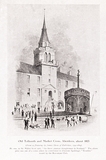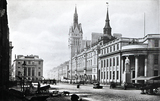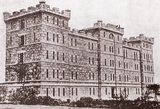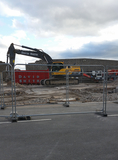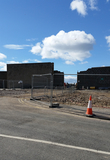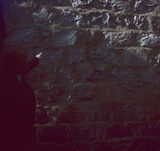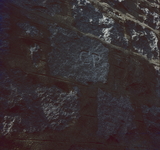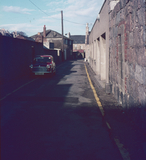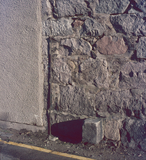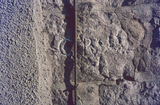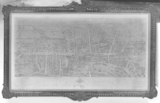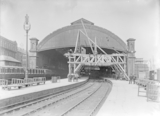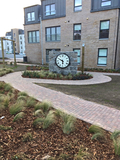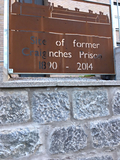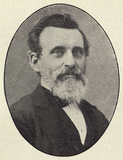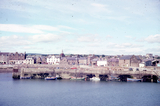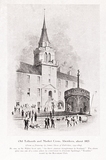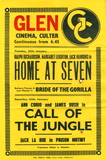|
Quick Search
|
Search Results
You searched for: More Like: 'Craiginches Prison'
36 items
items as
Gateway to Bridewell Prison
54 Gateway to Bridewell Prison, Rose Street, c.1880 - this massive gateway was the impressive entrance to the Bridewell in Rose Street, situated off the west end of Union Street. The Bridewell was opened in 1809 as a House of Correction and became known as the West Prison. It was in use till 1868, when it was closed and later demolished. For a short while, the site was laid out as the West End Pleasure Gardens and Recreation Grounds. The gateway had a porter's lodge and a guardhouse attached and it remained until 1883, when it was demolished to allow Rose Street to be extended northwards to link with Henry Street which in turn led on to Skene Street. Henry Street had been named after George Henry, Provost of the City between 1850-53 but the whole street then became known as Rose Street. The Tolbooth and Market Cross
496 The Tolbooth and Market Cross. The Tolbooth, once the city prison was built in 1615, architect Thomas Watson. It was extended in 1627 with the erection of the original spire. The present clock dates from 1817. The Town House built between 1868-74 was designed by Peddie & Kinnear, Edinburgh. The Castlegate
574 The Castlegate, Aberdeen. The Town House is in the centre of the photograph with the spire of the Tolbooth to the right. The Athenaeum Building is on the left and behind the statue of the Duke of Gordon is the headquarters of the North of Scotland Bank. Note the cannon to the left of the Market Cross.
In his Annals of Aberdeen (1818) William Kennedy states "In the year 1394, King Robert III granted to the burgesses and community a charter, dated 20th of October, by which he permitted them to build a tolbooth and court house, eighty feet in length, and thirty feet in breath, in any part of the town except in the middle of the market place. This edifice was accordingly soon afterwards erected on the north side of the Castlegate, on the site of the present town house." (page 403)
In 1615 a new prison replaced the one on this site and it stood for many years. It was largely replaced or subsumed by the new town house development in the 1870s, however the old Tolbooth spire can still be seen - as in this photograph (the right most spire). Bridewell Prison, Rose Street
793 The Bridewell prison stood on an area of ground between Rose Street and what was formerly called Henry Street. It opened to guests in 1809. The origin of the popular name is derived from a well between Fleet Street and the Thames, dedicated to St. Bride or Bridget. The Corporation of London gained possession of it and a large part of it was turned into a notorious prison. The Bridewell was closed when Caiginches was opened in 1891. The Bridewell
2089 The Bridewell or West Prison, Rose Street - the Bridewell stood in Rose Street, off the west end of Union Street. This photo was taken by William Garey, about 1868, when the building was being demolished. Bridewell was a name adopted by many institutions and recalls a London building dedicated to St. Bride which became used as a House of Correction. This building, designed by James Burn, was opened on 2 October 1809, as a House of Correction. It was surrounded by a 14 foot high wall with a garden enclosed. The gateway had a porter's lodge and guardhouse attached. There were 5 floors with the topmost being the hospital and storerooms. Each floor was divided by a gallery which ran the whole length of the building with a large windos at each end. On one side of the gallery there were 11 cells for work and on the other side 14 cells used for sleeping. Each work cell had 2 long narrow windows, while the sleeping cells only had one window. When the new Court House and jail were built in 1819 and named the East Prison, the Bridewell eventually became known as the West Prison. By the 1860s, the East Prison was adequate to cater for the number of inmates and the West Prison was closed in 1864. The building was demolished and its site became the works of James Garvie and Sons, carpenters and cabinetmakers. Craiginches Prison
2376 The remains of Craiginches Prison, also known as HMP Aberdeen, in 2016. The buildings have been demolished and the ground leveled. The Victorian prison was closed in January 2014, after 124 years of operation. It was shut down, along with HMP Peterhead, to make way for HMP Grampian.
The demolition was carried out by Fraserburgh firm David Smith Contractors. The site of the former prison is to be developed into modern housing and used to widen Wellington Road. This photograph was submitted to the Silver City Vault by Alison Murray, a member of staff at Airyhall Library. Craiginches Prison
2377 The remains of Craiginches Prison, also known as HMP Aberdeen, in 2016. The buildings have been demolished and the ground leveled. The Victorian prison was closed in January 2014, after 124 years of operation. It was shut down, along with HMP Peterhead, to make way for HMP Grampian.
The demolition was carried out by Fraserburgh firm David Smith Contractors. The site of the former prison is to be developed into modern housing and used to widen Wellington Road. This photograph was submitted to the Silver City Vault by Alison Murray, a member of staff at Airyhall Library, and features her German shepherd, Blade. Craiginches Prison
2396 The external wall of Craiginches Prison during demolition in mid-2015.
The Victorian prison was closed in January 2014, after 124 years of operation. It was shut down, along with HMP Peterhead, to make way for HMP Grampian.
The demolition was carried out by Fraserburgh firm David Smith Contractors. The site of the former prison is to be developed into modern housing and used to widen Wellington Road. This photograph was submitted to the Silver City Vault by Alison Murray, a member of staff at Airyhall Library. Craiginches Prison
2397 The demolition of Craiginches Prison being carried out by Fraserburgh firm David Smith Contractors in mid-2015. Craiginches Prison
2398 The external walls of Craiginches during the prison's demolition in mid-2015. Craiginches Prison
2413 The wall of Craiginches Prison being demolished as seen looking north from Walker Road. This photo was taken around September 2016 and was submitted to the Silver City Vault by Alison Murray, a member of staff at Airyhall Library. Freedom Lands and Marches of Aberdeen, Inner March Stone
2517 At the rear of 24-26 Thistle Street (Thistle House) on old boundary wall of Bridewell Prison. Freedom Lands and Marches of Aberdeen, Inner March Stone
2518 At the rear of 24-26 Thistle Street (Thistle House) on old boundary wall of Bridewell Prison. Freedom Lands and Marches of Aberdeen, Inner March Stone
2519 At Thistle Lane, about 100m from Thistle Street, on old boundary wall of Bridewell Prison. Freedom Lands and Marches of Aberdeen, Inner March Stone
2520 At Thistle Lane, about 100m from Thistle Street, on old boundary wall of Bridewell Prison. Freedom Lands and Marches of Aberdeen, Inner March Stone
2521 At Thistle Lane, about 100m from Thistle Street, on old boundary wall of Bridewell Prison. Treasure 31: Hays' Isometrical View of Aberdeen 1850
2586 In September 1850 an advert appeared in the local papers of Aberdeen for "Hays' Isometrical View of Aberdeen, giving a Distinct and Correct View of the Whole City and Environs". We hold copy of the plan from 1850 in our Local Studies collection.
The plan was available to purchase for 3s. 6d. and measured 34 inches by 19 inches. Carvers and gilders, J. & J. Hays, had premises at 2 Market Street where they also sold prints and optical instruments. At the bottom left of the image we see the words George Wilson, Delt. (abbreviation of delineator, i.e. the artist). George Wilson was to find fame a few years later as George Washington Wilson when he became one of Scotland's premier photographers.
George Washington Wilson
George Washington Wilson was born in 1823 at Waulkmill of Carnousie in Banffshire and left school at 12 years of age to be an apprentice carpenter. He practised his artistic skills by drawing portraits of friends and neighbours and, after training at art schools in Edinburgh and London, he returned to Aberdeen to become an art teacher and portrait painter.
By the late 1840's Wilson was attracted by the work of Fox Talbot in the new art of photography and after initial experiments with a homemade camera, he advertised a business offering photographic portraits before eventually expanding into landscape photography.
A Bird's Eye View of History
Wilson created this panoramic view of the city by making numerous sketches from the roofs of high buildings and then merging them into one comprehensive drawing. We are looking north across the city from the harbour with Union Street running horizontally across the centre and Old Aberdeen in the far distance. We can see how small the city actually was at this time - open fields are visible just to the north of the west end of Union Street.
A key to the most prominent buildings was provided and it is interesting to see which buildings have survived until today, often with additions, and which had yet to be built. Robert Gordon's Hospital (now College), Marischal College, and various churches including the Triple Kirks and St Nicholas East and West are all still standing but the West Prison, Castlehill Barracks and the Poorhouse have been demolished.
Bird's Eye View 1889
In December 1889, the Aberdeen Free Press offered its readers an updated version of the Bird's Eye View as a supplement to their newspaper. Numerous changes to the landscape of the city had taken place since Wilson's view. Gantry for removing station roof in 1912
2636 At the start of the 20th century work began to widen the station approach lines from Ferryhill with new sidings at Guild Street and Craiginches as well as a replacement locomotive depot at Ferryhill. Craiginches clock
2908 The old Craiginches clock as incorporated into the communal garden of the residential development that replaced the prison.
The garden was designed by Lina Khairy, a third year student at Robert Gordon University's Scott Sutherland School of Architecture.
The design was called 'Break Free' and topped a public poll of Torry residents. In addition to the clock face, the design used granite blocks from the prison's perimeter wall.
The garden was officially opened in December 2018 by Scottish Housing Minister Kevin Stewart MSP. The housing development, including 124 affordable homes, was created by a company called Santuary in partnership with the Scottish Government and Aberdeen City Council.
This photograph was submitted to the Silver City Vault by Alison Murray, a member of staff at Airyhall Library. Craiginches plaque
2909 A plaque at the Craiginches residential development marking the location as the old site of HMP Aberdeen.
This photograph was submitted to the Silver City Vault by Alison Murray, a member of staff at Airyhall Library. Daniel Macandrew
4182 A photographic portrait of Aberdeen builder and architect Daniel Macandrew (1827-1899). This image is sourced from In Memoriam: An Obituary of Aberdeen and Vicinity for the Year 1899 with Biographical Notes and Portraits of Prominent Citizens (William Cay & Sons). The book, one of a series published annually between 1890 and 1912, reproduces his obituary from the Aberdeen Free Press newspaper.
Macandrew was born in Fortrose, Ross and Cromarty. His family moved to Drumoak, Deeside, when he was young. He served as an apprentice architect and joiner in the offices of William Henderson and Baille Watson. He then started business on his own account. He lived and worked for a period in New Zealand, before returning to Aberdeen. At the time of his death, Macandrew lived at Vinery Lodge, Cults.
Amongst his works, he was contracted to build Peterhead Prison and various works for the University of Aberdeen, including the library at King's College and the Anatomy Rooms at Marischal College. He designed the Free John Knox Church, Gerard Street, the Free Church in Culsalmond, plus the Aberdeen Hydropathic Establishment, later the Bath Hotel.
Extensive information about Macandrew can be found in his entry on the Dictionary of Scotland Architects 1660-1980 website and in his newspaper obituaries. Stonehaven
4234 A photograph looking west into Stonehaven Harbour from the Breakwater.
A number of small boats can be seen moored alongside the Old Pier. Among them are fishing boats with Aberdeen registration numbers: A745 and A240. Cars, including a red Volkswagen Beetle, are parked around the harbour.
On the right side of the shore can be seen the Old Tolbooth, a listed 16th century former courthouse and prison. It now houses a local museum and a restaurant.
The road that curves around the harbour is called Shorehead. The three storey white building in the centre of this image is the Ship Inn. The Marine Hotel can be seen three buildings to the left.
The spire of Stonehaven Clock Tower, or Old Town Steeple, can be seen behind the Shorehead buildings.
The photograph comes from a collection of slides from the 1970s and 80s donated to Aberdeen City Libraries by Aberdeen City Council's publicity department. The Tolbooth and Market Cross
68 The Tolbooth and Market Cross. The Tolbooth, once the city prison was built in 1615, architect Thomas Watson. It was extended in 1627 with the erection of the original spire. The present clock dates from 1817. The Town House built between 1868-74 was designed by Peddie & Kinnear, Edinburgh. Glen Cinema Poster
407 A poster for the Glen Cinema in Culter advertising showings of Home at Seven (1952), Bride of the Gorilla (1951), Call of the Jungle (1944) and Prison Mutiny (1943).
The Glen Cinemas company showed films in various venues throughout the North East of Scotland during the 1930s to early 60s. One of these venues was Culter Community Centre.
Glen Cinemas was founded in 1936 by a local man called Arthur M. Burns. The company folded in 1961. Cinema equipment from the Culter Glen Cinema remained in the community centre for around 21 years before being sold by Burns to the London based collector Ronald Grant.
Grant was born in Banchory and worked as a projectionist in the Playhouse, Majestic and Kingsway cinemas in Aberdeen. He was also the assistant general manager of the Cosmo 2 in Diamond Street, before moving to the British Film Institute in London in 1967. The Ronald Grant Archive of Film and Cinematic Memorabilia remains active today.
Glen Cinemas also operated in the Shepherd's Hall in Bucksburn (also known as the Argosy Ballroom).
See the Aberdeen Press & Journal article 'Culter "upset" over cinema history loss' from 14th September 1982, page 3, and Michael Thomson's book Silver Screen in the Silver City (1988) for more information on Glen Cinemas. |




